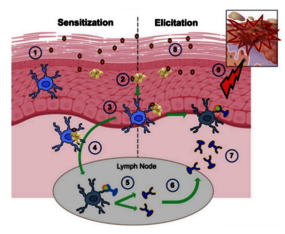Abstract
Purpose of Review
Although the biological mechanism of skin sensitization is a quite complex multi-stage process, the sensitization potency (or absence of potency) of a chemical is dependent on its chemical properties. Here we present an overview of the advances that have been made in our understanding of the chemical properties that determine sensitization potency, and how this understanding can be applied to rationalize existing data and to make predictions for new chemicals.
Recent Findings
It has been known for many decades that for a chemical to be a sensitizer it must be able to form a covalent reaction product with skin protein. There are several reaction mechanisms by which these covalent products can be formed. Five major mechanisms in which the sensitizing chemical is electrophilic are recognized. For each of these mechanisms we summarise how these are related to chemical structure and what is now understood about the relationship between chemical properties and sensitization potency. A further mechanistic domain recently recognized, covering chemicals reacting as nucleophiles, is also discussed. Recent developments have made it possible to investigate free radical chemistry in cutaneo, and we discuss how these can be applied to investigate free radical sensitization mechanisms.
Summary
An update on the chemistry related to skin sensitization is presented.
Reference
Chemical Aspects of Allergic Contact Dermatitis: A 21st Century Perspective
Elena Giménez-Arnau, Bertrand Vileno & David W. Roberts
Current Treatment Options in Allergy, Published: 27 June 2025, Volume 12, article number 17, (2025) – DOI : https://doi.org/10.1007/s40521-025-00394-z
Contacts
Elena Giménez-Arnau & Bertrand Vileno, équipe POMAM, Institut de Chimie de Strasbourg (UMR 7177).



![[Translate to English:]](/websites/_processed_/0/4/csm_signature-unistra_fee3442f1d.png)
![[Translate to English:]](/websites/_processed_/0/e/csm_logo-cnrs_c0f610620b.png)
![[Translate to English:]](/websites/_processed_/9/4/csm_logo-fondation-lehn_24043a5484.png)